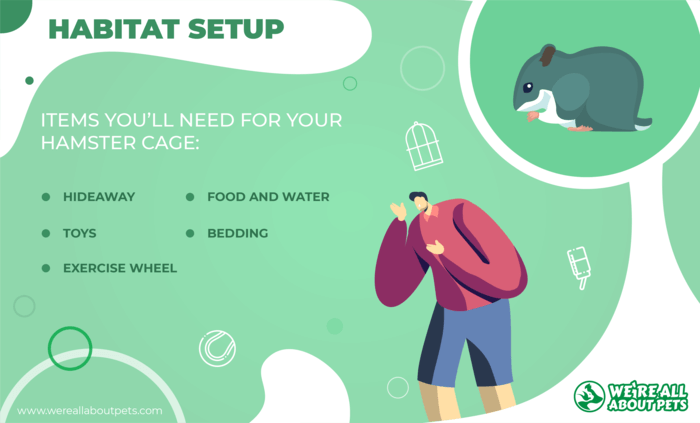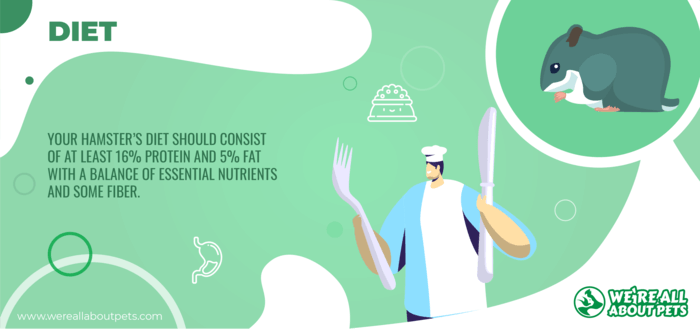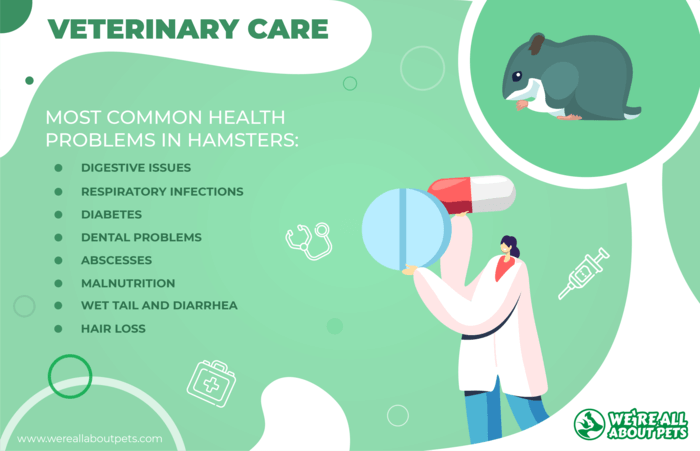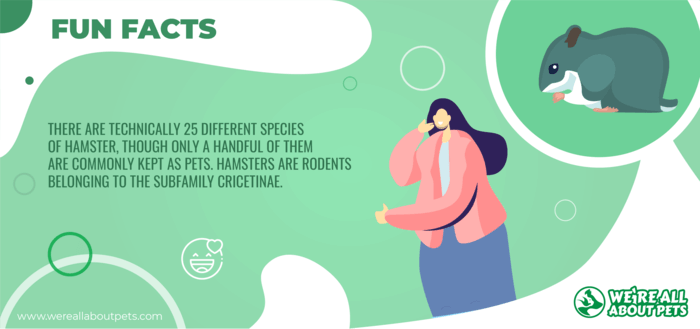How To Care For A Hamster?
This page contains affiliate links. We may earn money or products from the companies mentioned in this post through our independently chosen links, which earn us a commission. Learn More
General Stats:
- Pet Type: Small animal
- Size: 2 to 5 inches
- Diet: Omnivore
- Lifespan: 2 to 3 years
Whether you’re looking for a beginner-friendly pet or something that doesn’t cost a lot to get started with, a hamster might be a good choice. Not only do hamsters not take up a lot of space, but their needs are fairly straightforward and easy to meet.
Though hamsters may be fairly low maintenance in terms of keeping a pet, there is still some responsibility involved. Make sure you can accommodate for your hamster’s needs for a nutritious diet and proper health care in addition to providing an adequate environment before you commit.
Here’s what you need to know about proper care of a hamster.
Habitat Setup For Hamsters

When it comes to setting up the ideal habitat for your new hamster, you may want to consider the type of hamster you’re getting.
Syrian hamsters and teddy bear hamsters are significantly larger than dwarf hamsters, so that might impact your choice of cage. No matter what type of hamster you pick, a bigger cage is almost always better.
Before choosing the supplies for your hamster’s cage, you’ll need to decide what kind of cage you want. The two primary options are an enclosed cage or a wire cage.
Wire mesh cages are good for many small animals like the guinea pig or chinchilla, but hamsters might be able to squeeze through the bars. An enclosed cage may be more secure, but there are greater concerns about ventilation. Shop around to see the different options before you make a choice.
Here are some of the items you’ll need for your hamster cage:
- Hideaway – Because hamsters are nocturnal, you’ll want to provide a hideaway or two for your pet to sleep in during the day. Some hamsters tend to burrow into their bedding more than others, but it’s still a good idea to provide a structure if your hamster chooses that option.
- Toys – Hamster toys help keep your pet mentally engaged and physically active, so try to provide a wide variety of options including chew toys for dental health.
- Exercise Wheel – Hamsters are extremely active and need a great deal of exercise to stay healthy. You can choose an open or enclosed hamster wheel but know the risks of both. Open wheels can get your pet’s feet caught but your hamster might fill an enclosed wheel with food.
- Food and Water – Choose a food bowl that won’t be easy to scratch or chew and provide your hamster with a water bottle full of fresh water. Be sure to clean both daily.
- Bedding – Wood shavings are a popular bedding for hamsters because they absorb liquid and odor. Hamster bedding should be made from nontoxic materials like aspen, recycled paper, timothy hay, or natural fibers. Avoid using cat litter, pine, or cedar.
Once you have brought your new hamster home and have set up your hamster’s home, you should double-check that everything is correct. Make sure to place the cage out of direct sunlight and double- and triple-check that it is escape-proof.
Hamsters can be sneaky and have been known to escape from even the most secure-looking enclosures.
One way to help reduce the risk that your hamster will escape is to make sure he gets his exercise.In addition to a hamster wheel in the cage, consider an exercise ball your hamster can use to get a little extra exercise.
A hamster ball is also a safer way for your new pet to explore the world outside his home.
Also Read: The Cost of Owning a Hamster
Hamster Diet

Wild hamsters are omnivorous, eating a wide variety of foods including seeds, nuts, grains, fruits, vegetables, insects, and more.
Basically, whatever they can find. Keep in mind that because hamsters are small animals, they won’t need a large volume of food. The average dwarf hamster only eats a tablespoon or two of food per day while Syrian hamsters might eat a little more.
Here are some quick facts about the ideal hamster diet:
- Your hamster’s diet should consist of at least 16% protein and 5% fat with a balance of essential nutrients and some fiber.
- Commercial hamster food is the best way to ensure that your pet hamster gets the ideal balance of nutrients – just make sure it is made from high-quality, natural ingredients.
- If you choose to feed your hamster seed mix instead of pelleted food, make sure the mix contains a wide variety of foods to ensure nutritional variety.
- Supplement your hamster’s diet with fresh food like fruits and vegetables as well as treats like dried insects, dried fruit, and roasted nuts.
- Fresh timothy hay and alfalfa hay can be added to your hamster’s diet twice a week to provide fiber and other essential nutrients.
In addition to hamster food, be sure to provide your pet with unlimited access to fresh water as well.
In the wild, hamsters get the majority of their hydration from their food, but you’ll need to provide a water bottle. A small pet water bottle is perfectly fine – just make sure to clean it and refill it on a daily basis.
Also Read: What Do Hamsters Eat?
Hamster Veterinary Care

As a hamster owner, you are directly responsible for your pet’s health.
Providing your hamster with a nutritious diet and a suitable habitat are the best things you can do to keep your pet healthy. Even if you provide these things, however, hamsters are prone to certain health issues.
Here are some of the most common health problems in hamsters:
- Digestive issues
- Respiratory infections
- Diabetes
- Dental problems
- Abscesses
- Malnutrition
- Wet tail and diarrhea
- Hair loss
You can’t expect every veterinarian to be comfortable caring for hamsters – you may need to find a small animal vet or an exotics vet. It’s a good idea to find a local vet before bringing your new pet home.
Most hamsters don’t need more than an annual checkup, though you should keep an eye on your pet’s health in between visits and take him in if you see signs of illness.
Unfortunately, by the time you notice that your hamster is sick, the issue may have progressed past the point of treatment. Emergency vet care can be expensive as well, so be prepared to make a difficult choice.
Hamster Fun Facts

- There are technically 25 different species of hamster, though only a handful of them are commonly kept as pets. Hamsters are rodents belonging to the subfamily Cricetinae.
- In the wild, hamsters typically live in burrows where they sleep underground during the day and come out to forage for food at night. They feed primarily on seeds, grains, fruits, and vegetables but will sometimes eat insects and small animals as well.
- Most hamsters are very solitary animals and do not like to be kept with other pets – the only real exception is Roborovski hamsters which tend to do well in pairs.
- Hamsters can reproduce very quickly because they have large litter sizes and a short gestation period. The average gestation period for hamster is only 16 to 22 days and litters can have as many as 20 pups each.
- Though many people think hamsters are nocturnal, their habits are closer to that of other crepuscular animals. They become active during dawn and dusk hours but, in captivity, are most likely to sleep during the day and become active at night.
- Hamsters need a lot of exercise, so it’s important to have a hamster wheel. You need to be careful about choosing the right wheel, however, because if it is too small it could cause spinal injury or lead to arthritis.
If you’re looking for a low maintenance pet, the hamster is not for you. However, if you’re considering an exotic pet and you’re willing to commit a significant amount of time and effort, the hamster might be one to consider.
Keep in mind conservation concerns when it comes to keeping exotic pets and make sure it is legal to do so in your area.
Frequently Asked Questions
How long do hamsters live?
The average lifespan for a pet hamster is between 2 and 3 years. Proper hamster care involves providing your pet with a healthy diet and access to veterinary care when needed.
How much do hamsters cost?
Hamsters are not expensive pets to keep, though your costs will vary depending on the quality of the supplies you choose. At the pet store, a hamster will only cost you $5 to $20, depending on the type of hamster. You’ll spend another $30 to $75 on a hamster cage and a little more on bedding, food, and other supplies. You may also want to factor in the cost of your first vet checkup. All told, however, you’ll probably spend less than $200 to get started with a hamster.
How big do hamsters get?
The average size of an adult hamster depends on the species. Roborovski dwarf hamsters are the smallest, growing to a length of around 2 inches on average. The Chinese hamster is similar in size to the Dwarf Campbell’s Russian hamster and the Dwarf White Russian, all growing 3.5 to 4 inches. The Syrian hamster, also known as the teddy bear or golden hamster, is the largest and grows 6 to 8 inches long.
What do hamsters eat?
Hamsters are omnivores, though they feed primarily on seeds nuts, and grains in the wild with small amounts of fruits and vegetables. Some hamsters will also eat insects, lizards, and other small animals. In captivity, hamsters usually eat seed mixes or commercial pelleted hamster food.
Are hamsters good pets?
For the most part, hamsters are a good pet and very beginner friendly. As a small pet, they don’t take up as much space as traditional pets like dogs or cats and they are less expensive to care for as well. Because they are kept in an enclosed cage, however, you’ll need to clean the cage weekly.
Are hamsters messy?
Hamsters can be a little messy, though most of the mess will be contained in the hamster’s cage. Some hamsters tend to choose one corner of their cage to do their business in, however, which might make cleaning a little easier. Remember as well that hamsters tend to hide food away, carrying it around in their cheek pouches, so check the cage occasionally for food stashes so the food doesn’t go bad.
Where do hamsters come from?
Hamsters were first discovered in Syria, though they can also be found throughout Greece, Belgium, Romania, and northern China. Wild hamsters tend to prefer warm, dry areas.
Do hamsters bite?
Most hamsters are friendly by nature, but they will occasionally nip if they feel threatened. Some species are more amenable to handling than others, however.
Do hamsters sleep?
The hamster is a crepuscular animal that tends to be most active during twilight hours at dusk and dawn. Most pet hamsters sleep during the day and become active at night.
How long are hamsters pregnant for?
Hamsters have fairly short gestation periods averaging just 16 to 22 days. The gestation period varies by species with the Syrian hamster being the shortest. Hamsters give birth to as many as 20 pups per litter, though the average is 6 to 12.









